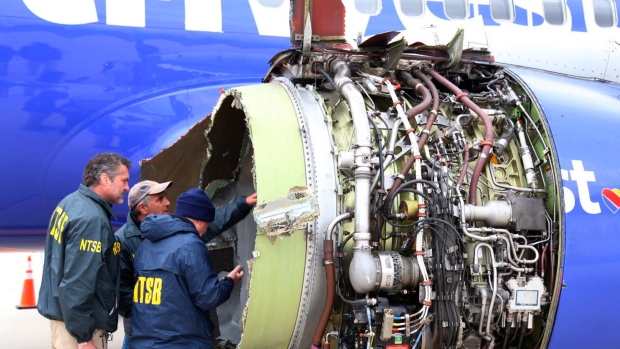Apr 17, 2018
Southwest CEO faces major test as airline grapples with aftermath of deadly accident
, Bloomberg News

Southwest Airlines Co. is stepping up engine inspections as the discount carrier known for its quirky cheerfulness and strong safety record grapples with the aftermath of its first accident to kill a passenger.
Ultrasonic examinations of the fan blades on its CFM56 engines will be completed within 30 days, Southwest said. The airline, which operates the world’s largest fleet of Boeing Co. 737 jetliners, relies on the turbofan to power its more than 700 planes.
The National Transportation Safety Board found indications of metal fatigue, an area of weakness caused by repeated bending, where a fan blade on the engine was missing, NTSB Chairman Robert Sumwalt said in a briefing late Tuesday. One woman died after shrapnel from the blast tore through a window about 20 minutes into the flight from New York to Dallas.
“This is a very sad day, and on behalf of the entire Southwest family I want to extend deepest sympathies for the family and loved ones of the deceased customer,” Southwest Chief Executive Officer Gary Kelly told reporters, speaking in an auditorium called Freedom Hall at Southwest’s headquarters in Dallas. “We will do all we can to support them during this very difficult time and in the difficult days ahead.”
The death was the first in-flight fatality due to an accident in the 47-year history of Southwest. That doesn’t include a 2005 episode when one of the carrier’s jets skidded off a snowy runway onto a Chicago road and killed a six-year-old boy in a car.
ACCIDENT PROBE
Federal investigators along with teams of technical experts from Boeing and engine maker CFM International, a venture of General Electric Co. and France‘s Safran SA, are gathering clues about what caused the accident.
The CFM turbofan, one of the most widely used jet engines, has amassed more than 350 million flight hours on 6,700 aircraft since entering the market in 1997.
There have been “only a handful” of failures with the engine, Kelly said. It would be “premature to even link it to other engine failures that have occurred.”
Southwest has more than 500 of Boeing’s 737-700 jets, the aircraft variant that was involved in the incident. While Southwest’s average flights have been getting longer as the company has grown into the No. 4 U.S. carrier, the carrier is still known for doing more of the shorter hauls than full-service airlines with flights that cross oceans. The relatively high number of takeoffs and landings puts added stress on the planes and engines.
“Anytime you run an engine like that to maximum power and hold it there for a couple of minutes on takeoff, you are putting maximum stress on all the rotating parts,” said John Nance, a former airline and military pilot. “You can’t deny that the more you run an engine up to full power on takeoff, the more you stress those blades.”
The stress those operations put on the aluminum frames of Southwest’s 737 jetliners has been raised before, notably after a hole ripped the fuselage skin roof of an aircraft in mid-flight in 2011. The metal fatigue was later linked to the technique Boeing workers used to assemble the aircraft family, which Southwest retired last year.
EARLIER INCIDENT
Investigators will also want to know if there is any relation between Tuesday’s engine blowout and an uncontained engine failure that spewed shrapnel on a Southwest airplane cruising above the Gulf of Mexico in 2016, Sumwalt said.
On that plane, also a 737-700, a fan blade on a jet engine snapped off and sent debris slamming into the fuselage, NTSB investigators determined. They found evidence of a crack “consistent” with metal fatigue in the titanium-alloy blade. The jet was forced to make an emergency landing in Pensacola, Florida, after parts of the left engine broke apart, damaging the fuselage, wing and tail. The plane lost cabin pressure and passengers tweeted pictures of themselves with oxygen masks on.
Modern jet engines contain a series of spinning fans and if one of them breaks apart it can eject blades and other metal debris at high speeds. Engine manufacturers and airlines conduct periodic inspections on planes designed to spot any evidence of cracks or weakening of the metal due to fatigue.
After the latest accident, Kelly said Southwest would work “with the NTSB to make sure we understand the root cause, and any further actions we need to take in terms of maintenance or inspections we’ll want to add to our program.”
The airline’s shares fell 1.1 per cent to US$54.27 at the close in New York, after falling as much as 3.1 per cent after the NTSB announced the fatality.
'CLOSE-KNIT COMPANY'
“Southwest is a close-knit and attentive company,” said David Greenberg, founder of Compass Group Aviation Consulting. “They’ll first focus on the needs of the survivors, both the uninjured and those that lost a family member. The internal people take that very, very seriously. They will support each other as they go through the investigation.”
The latest incident marks a tragic milestone for an airline that has had a strong track record of safety, said Bob Mann, a former airline executive who now heads aviation consultant R.W. Mann & Co.
While the situation may not have a long-term impact on Southwest’s business, the company faces a critical test with its handling of the situation, he said.
“They’ve responded to it very well,” Mann said, citing Kelly’s initial comments. “I think they’ve approached it very professionally -- not clinically, but with an eye toward the sort of personalized relationship they’d like to have with their customers.”
--With assistance from Richard Clough


